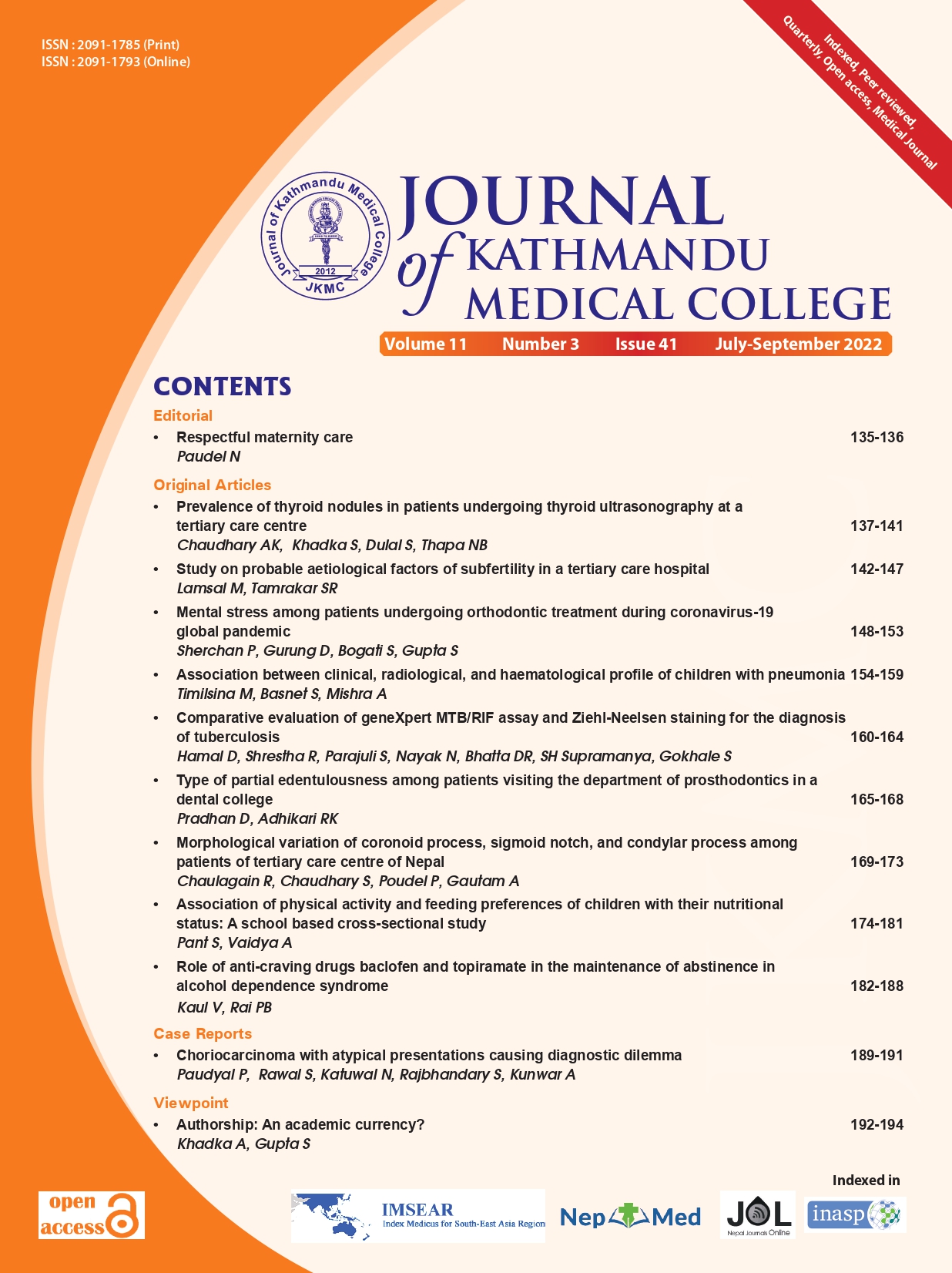Type of partial edentulousness among patients visiting the department of prosthodontics in a dental college
DOI:
https://doi.org/10.3126/jkmc.v11i3.50788Keywords:
Jaw, Edentulous, PartiallyAbstract
Background: There are various combinations of partial edentulism pattern in mandible and maxilla. Documenting the pattern of tooth loss is important for health care planning as it indicates the health of people and satisfaction of oral health care system.
Objectives: To find out different types of partial edentulism among patients who come to the Department of Prosthodontics for prosthesis.
Methods: A descriptive cross sectional study was carried out in 350 patients at Kathmandu Medical College and Teaching Hospital (KMCTH) visiting Department of Prosthodontics over the period of three months (July 2021 - September 2021) by convenience sampling method with complaint of partial edentulism. Ethical approval for the study was granted by Institutional Review Committee of KMCTH on 8th June 2021. The data obtained were entered and analysed using Statistical Package for Social Sciences (SPSS) v.18.
Results: Single most common reason for tooth loss was found to be dental caries (102,29.14 %). Multiple most common reason for tooth loss were dental caries and periodontal disease (117,33.43 %). Partial edentulism in maxillary arch only 112(32%), in mandibular arch only 172(49.14%) and in both arches 66(18.86%). Kennedy’s Class III type of edentulism was most common in both maxillary arch 104 and mandibular arch 157.
Conclusion: Kennedy’s Class III is most common type of partial edentulism in both maxillary and mandibular arch. Preventive programs targeted at reducing tooth loss need to be developed and implemented at national level since most prevalent cause of tooth loss is preventable.
Downloads
References
Nordenram G, Davidson T, Gynther G, Helgesson G, Hultin M, Jemt T, Lekholm U, Nilner K, Norlund A, Rohlin M, Sunnegårdh-Grönberg K, Tranæus S. Qualitative studies of patients' perceptions of loss of teeth, the edentulous state and prosthetic rehabilitation: a systematic review with meta-synthesis. Acta Odontol Scand. 2013 May-Jul;71(3-4):937-51. [PubMed?Full Text?DOI]
Peltzer K, Hewlett S, Yawson AE, Moynihan P, Preet R, Wu F, Guo G, Arokiasamy P, Snodgrass JJ, Chatterji S, Engelstad ME, Kowal P. Prevalence of loss of all teeth (edentulism) and associated factors in older adults in China, Ghana, India, Mexico, Russia and South Africa. Int J Environ Res Public Health. 2014 Oct 30;11(11):11308-24. [PubMed?Full Text?DOI]
Madhankumar S, Mohamed K, Natarajan S, Kumar VA, Athiban I, Padmanabhan TV. Prevalence of partial edentulousness among the patients reporting to the Department of Prosthodontics Sri Ramachandra University Chennai, India: An epidemiological study. J Pharm Bioallied Sci. 2015 Aug;7(Suppl 2):S643-7. [PubMed?Full Text?DOI]
Vadavadagi SV, Srinivasa H, Goutham GB, Hajira N, Lahari M, Reddy GT. Partial Edentulism and its Association with Socio-Demographic Variables among Subjects Attending Dental Teaching Institutions, India. J Int Oral Health. 2015;7(Suppl 2):60-3. [PubMed?Full Text]
El-Meligy O, Maashi M, Al-Mushayt A, Al-Nowaiser A, Al-Mubark S. The Effect of Full-Mouth Rehabilitation on Oral Health-Related Quality of Life for Children with Special Health Care Needs. J Clin Pediatr Dent. 2016 Winter;40(1):53-61. [PubMed?Full Text?DOI]
Umar Shah M, Qamar K, Zakir A, Hammad Azeem S, Aqeel R, Syed S. The frequency and pattern of partial Edentulism in patients reporting to Prosthodontic Department: A Cross-sectional observational study. Vol. 13, Isra Med J. |. [Full Text]
Singh SK, Alvi HA, Ramashankar, Singh S V., Mishra N, Singh K, et al. Hospital-based pilot study on partially dentate and edentate patients to evaluate disparity between prosthodontic treatment demand and need: A cross-sectional sociodemographic study. Clin Epidemiol Glob Heal. 2016;4:S29–35. [Full Text?DOI]
Miller EL. Systems for classifying partially dentulous arches. J Prosthet Dent. 1970 Jul;24(1):25-40. [PubMed?Full Text?DOI]
Gopal TM, Subhashree R. Prevalence of kennedy classification in partially edentulous patients - A retrospective study. Indian J Forensic Med Toxicol. 2020;14(4):5585–91. [Full Text?DOI]
Carr AB, Brown DT. McCracken’s removable partial prosthodontics,. 13th ed. St. Louis, Missouri: Elsevier; 2016. 16–20 p. [Full Text ]
Bhandari A, Manandhar A, Manandhar P. Partial Edentulousness in Patients Visiting the Dental Out-Patient Department of Gandaki Medical College, Pokhara, Nepal. J Gandaki Med Coll. 2019;12(2):28–31. [Full Text]
Tyrovolas S, Koyanagi A, Panagiotakos DB, Haro JM, Kassebaum NJ, Chrepa V, Kotsakis GA. Population prevalence of edentulism and its association with depression and self-rated health. Sci Rep. 2016 Nov 17;6:37083. [PubMed?Full Text?DOI]
Papapanou PN. Periodontal diseases: epidemiology. Ann Periodontol. 1996 Nov;1(1):1-36. [PubMed?Full Text?DOI]
Yasser A. Araby, Abdurrahman S. Almutairy and Fawaz M. Alotaibi. Pattern of Partial Edentulism in Correlation to Age and Gender among a Selected Saudi Population. International Journal of Dental Sciences and Research. 2017; 5(1):1-4. [Full Text]
Downloads
Published
How to Cite
Issue
Section
License

This work is licensed under a Creative Commons Attribution-NonCommercial 4.0 International License.
Copyright © Journal of Kathmandu Medical College
The ideas and opinions expressed by authors or articles summarized, quoted, or published in full text in this journal represent only the opinions of the authors and do not necessarily reflect the official policy of Journal of Kathmandu Medical College or the institute with which the author(s) is/are affiliated, unless so specified.
Authors convey all copyright ownership, including any and all rights incidental thereto, exclusively to JKMC, in the event that such work is published by JKMC. JKMC shall own the work, including 1) copyright; 2) the right to grant permission to republish the article in whole or in part, with or without fee; 3) the right to produce preprints or reprints and translate into languages other than English for sale or free distribution; and 4) the right to republish the work in a collection of articles in any other mechanical or electronic format.




